Because of age, disability, or illness, mobility can become a concern for all of us. Consequently, people who suffer from a lack of mobility seek alternative ways to get around, and mobility scooters are one of the most popular options.
Over the years, the demand for these devices has seen a notable rise due to the independence and freedom they offer their users as well as improving technologies and falling prices.
Therefore, tapping into this expanding market presents a massive commercial opportunity for businesses. If sellers can align their inventories with the diverse needs of such consumers, they can build a loyal customer base while contributing positively to the quality of life for many individuals.
Here we’ll cover the types of mobility scooters available so that you can decide which are the most suitable for your inventory.
Table of Contents
Mobility scooter market share and size
Types of mobility scooters
Important factors for businesses when stocking mobility scooters
Conclusion
Mobility scooter market share and size
In the last couple of years, the market value of mobility scooters has seen a steady rise, and is expected to continue. According to Allied Market Research, the market is projected to grow at a CAGR of 6.5%, reaching US $3.21 billion by 2030 from an initial value of US $1.72 billion in 2020. This steady climb indicates the market’s resilient demand and the industry’s innovation capacity.
This surge is being driven by a combination of demographic shifts and technological advancements. An aging global population and an increase in mobility-related impairments have heightened the need for mobility solutions that scooters provide. In addition, innovations in electric mobility scooter technology and a push towards eco-friendly transportation options are contributing to the expansion of the market.
To make the most of this expanding market, sellers should focus on offering a variety of high-quality scooters that meet the different needs of their customers. Investing in scooters with long-lasting batteries, comfortable seating, and reliable safety features may be the key to capturing a larger market share.
Types of mobility scooters
Travel/portable scooters
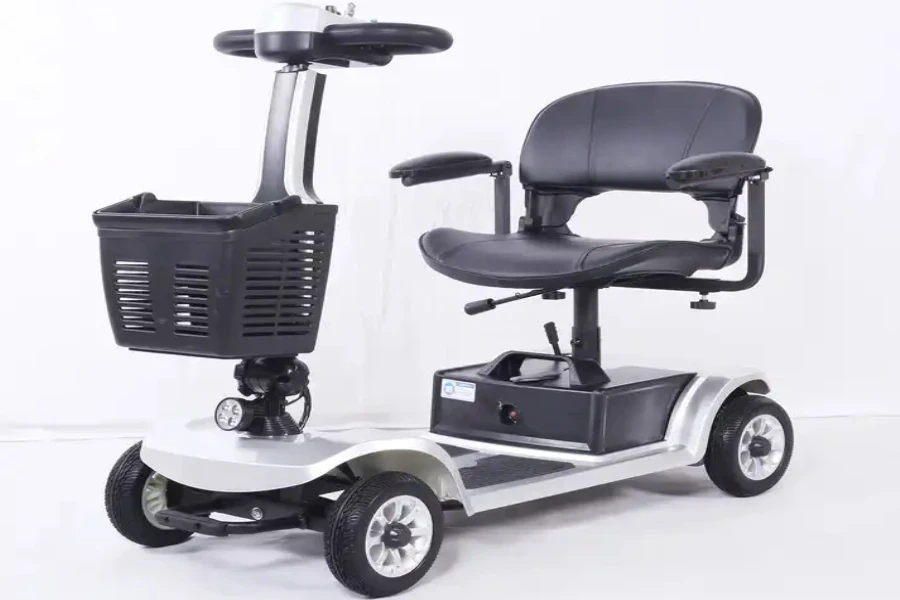
Travel mobility scooters have carved out a significant niche in the mobility scooter market. Prized for their lightweight designs, these scooters are popular among individuals who continue to value an active lifestyle. They offer a blend of convenience and functionality, with most models featuring easy-to-use controls and efficient battery life, suitable for navigating indoor spaces and smooth outdoor terrains. These scooters are ideal for users who desire independence on short trips, such as quick visits to the grocery store or leisurely drives in the park.
According to Google Ads, average monthly searches for travel scooters in the US increased by 8.5% in the past six months. This demonstrates a rising consumer interest that sellers can maximize on.
Folding scooters
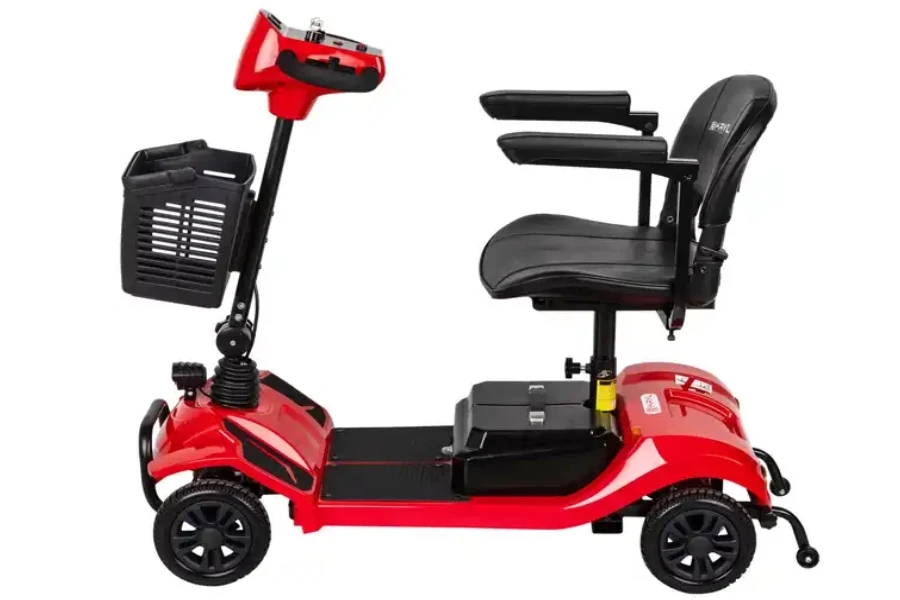
Folding scooters are another mobility scooter option that is quickly becoming a hallmark of modern mobility aids. These scooters offer unparalleled convenience with their collapsible frames that ensure users can easily store or transport them. They are popular among commuters and those with limited storage since they can fit neatly into the trunk of a car or tucked away in a closet. Even better, most feature automated folding systems that transform the scooter into a compact form at the push of a button.
According to Google Ads, the average monthly search for folding scooters in the US increased by 7.67% in the last six months, potentially indicating a market that is leaning towards mobility aids that support busy, on-the-go lifestyles.
Three-wheel scooters
Three-wheel scooters are a perfect combination of maneuverability and comfort. They feature a single front wheel that enables tight turns and easy navigation in confined spaces. Moreover, they provide more legroom, which can be a significant comfort factor for users. They are particularly suited for indoor use, offering a smooth ride in malls, museums, and other public spaces where agility is crucial.
The consumer interest in three-wheel scooters is also encouraging, as reflected in their search popularity. Google Ads data recorded a 7% increase in average monthly searches in the last six months in the US, underscoring the potential for growth in this segment.
Four-wheel scooters
Four-wheel scooters offer optimized stability and support, which makes them the preferred choice for individuals who wish to navigate uneven outdoor terrain or want a sturdier mobility solution. Thanks to their four-wheel base, these durable mobility scooters are designed to offer a more stable ride, catering to users who prioritize safety across various terrains.
In the last six months, average monthly searches for four-wheel scooters increased by 8.67% in the US, according to Google Ads data.
Small mobility scooters
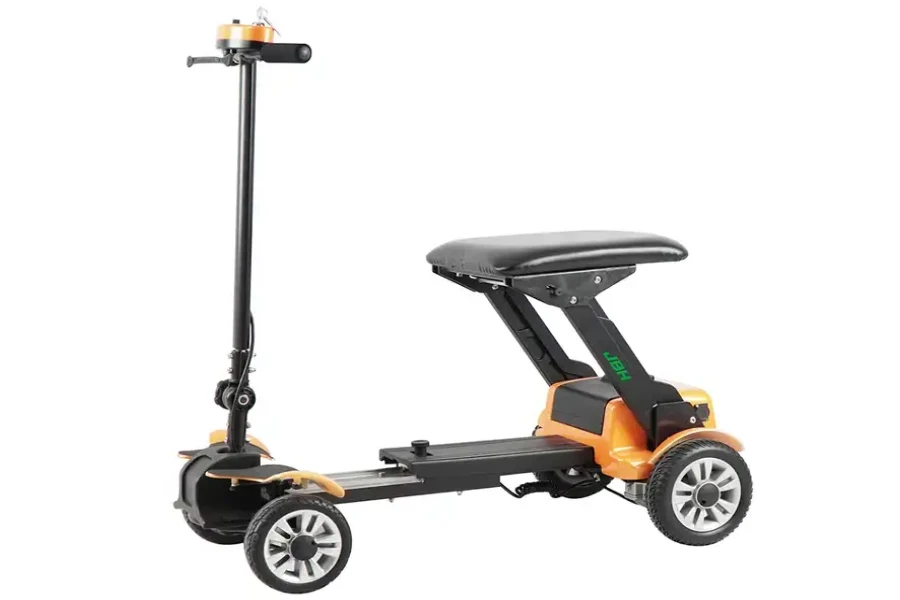
Small mobility scooters strike a balance between the compactness of travel scooters and the robustness of their larger counterparts. They are designed for those who prioritize space-saving features but do not wish to compromise on performance and comfort. These scooters often feature easy-to-operate controls and modest amenities, making them suitable for daily use in different settings.
Google Ads data reveals a 9% increase in average monthly searches in the last six months for these types of scooters in the US, indicating a healthy demand for scooters that can fit into smaller living spaces or maneuver easily in crowded areas.
Mid-size mobility scooters

Mid-size mobility scooters represent a compromise between size, power, and portability, combining elements of both larger and smaller scooters to suit various users’ needs. They deliver enhanced comfort with larger seats, more legroom, and increased battery life without being too bulky, making them suitable for both indoor and outdoor use and users seeking a reliable ride for longer distances or those who enjoy outdoor activities but require a bit of assistance.
Google Ads data recorded a 9% increase in average monthly searches for mid-size scooters in the last six months in the US.
Full-size scooters
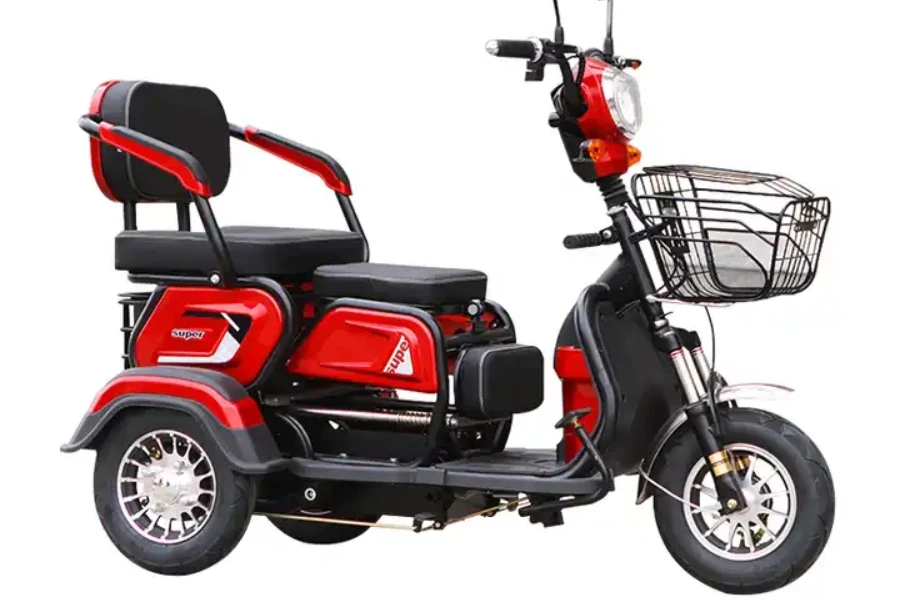
Full-size scooters are built for maximum comfort and durability. They are ideal for users with extensive mobility needs or who desire a scooter that can serve as a full-time mobility aid. These scooters often come with many impressive features, including high-backed seats, full lighting packages, and larger weight capacities. They are built to handle more rugged terrain and provide stable rides over long distances.
Due to their comprehensive mobility solutions, full-size scooters are a popular mobility solution, with Google Ads statistics recording a 7.67% increase in average monthly searches in the last six months in the US. Businesses stocking full-size scooters are well-placed to serve users looking for robust mobility options, often for constant, daily use.
Heavy-duty scooters
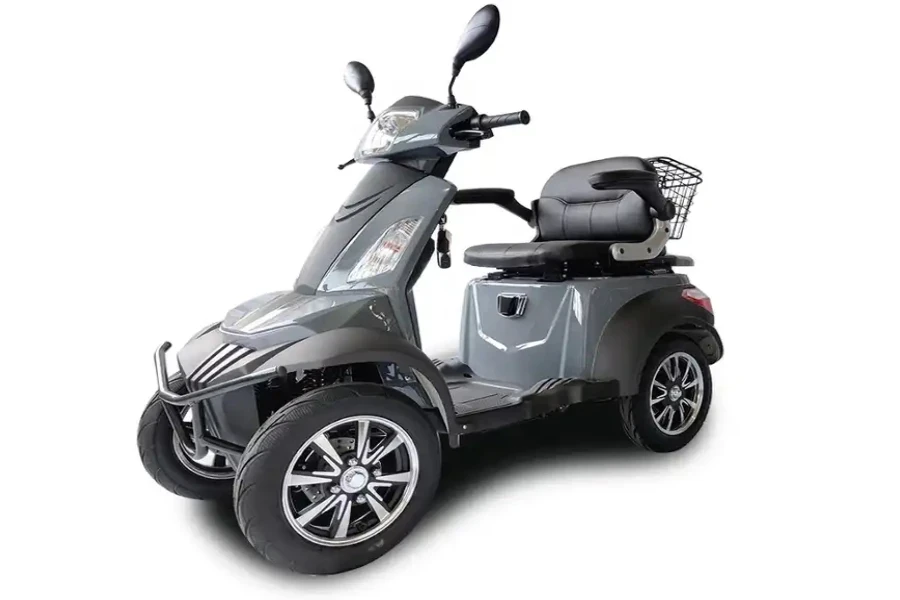
Heavy-duty scooters are the powerhouse of mobility scooters. These durable mobility aids accommodate higher weight limits as well as a sturdy, dependable ride across various terrains. In addition, they are equipped with larger tires, powerful motors, and extensive per-charge ranges, making them ideal for individuals who need a more substantial mobility aid.
The heavy-duty scooter market has grown extensively, as backed by Google Ads, which reports an 8% increase in average monthly searches in the last six months in the US. Sellers stocking heavy-duty scooters can meet the needs of a customer base that requires mobility scooters capable of providing support and reliability beyond the standard models.
Important factors for businesses when stocking mobility scooters
The mobility scooter landscape is quite competitive. This means businesses that want to stock these products must be smart in their approach. By keeping the following important factors in mind, businesses can tailor their offerings to meet customer needs effectively, ensuring satisfaction and fostering loyalty.
Target market
It is imperative for businesses to understand their target market before stocking. This involves researching and recognizing the specific needs, preferences, and limitations of potential customers. Ideally, different customer groups may require different types of mobility scooters. For example, elderly users might prefer scooters that offer maximum comfort and easy operation, while those with more active lifestyles might look for lightweight, easily transportable models.
Quality and durability
When selecting mobility scooters to stock, understanding build quality and materials is important. A scooter’s ability to withstand daily use without compromising its performance is critical for consumers. Stocking scooters from reputable manufacturers ensures that products are durable, safe, and reliable. Moreover, high-quality scooters often require less maintenance and have longer lifespans, which is a key selling point. This instills confidence in the consumer and enhances your business’s reputation for selling reliable products.
Product range
Offering a diverse range of products is essential to cater to a varied customer base. This means having different types of scooters in your inventory. Remember, each scooter comes with unique features, such as battery life, speed, terrain capability, and additional accessories. By providing a wide selection, your business can meet the specific needs of different users, from those requiring a scooter for occasional outings to those who rely on their scooter for daily mobility.
Pricing strategy
Setting the right price is often a delicate balance. It involves understanding the cost of the scooters, competitors’ prices, and the financial capacity of the target market. Ideally, your pricing should be competitive enough to attract customers but also high enough to ensure a reasonable profit margin. To strike a good balance, you need to consider various factors, including the cost of procurement, operational expenses, and the perceived value of the scooters. A well-planned pricing strategy can not only help you drive sales but also position your business well in the market, whether as a budget-friendly option or a premium provider.
Warranty and service
Offering appealing warranty terms and reliable after-sales services significantly influences customer satisfaction and loyalty. A mobility scooter is a significant investment for any user, and the assurance of support in case of defects or issues is a major deciding factor. This includes providing timely repair services, replacement parts, and possibly even loaner scooters during repair periods. Efficient after-sales service ensures that customers feel supported after their purchase, increasing the likelihood of repeat business and recommendations.
Supply chain management
Efficient supply chain management is critical to ensure that there is always adequate stock in your inventory. This involves establishing relationships with reliable suppliers, managing inventory levels effectively, and ensuring the timely delivery of products. A well-managed supply chain minimizes the risk of costly stockouts, which can lead to lost sales and dissatisfied customers. It also helps you to respond quickly to changes in demand, staying agile and competitive in a dynamic market.
Conclusion
The mobility scooter market is growing, and sellers must adapt to users’ diverse and expanding needs to stay competitive. As a seller, this means ensuring your product range includes mobility scooters that satisfy a wide array of customer preferences and requirements.
By offering a well-thought-out selection of mobility scooters, each catering to different needs and lifestyles, you’re not just equipping your customers with a means of transport, you’re enabling their lifestyle aspirations. This strategic diversity in your stock can lead to an expanded customer base and, inevitably, a substantial increase in sales.
Retail platforms such as Alibaba.com can serve as a barometer for the latest trends and most sought-after features in mobility scooters, helping you to stay well-informed and relevant.




